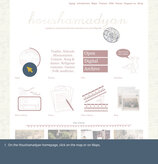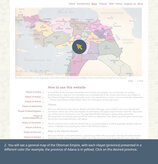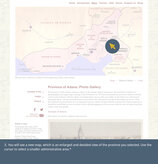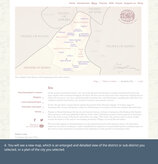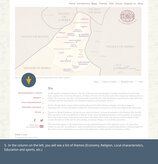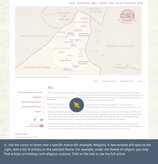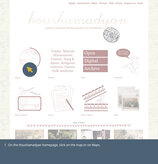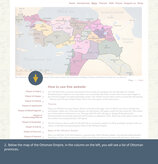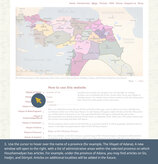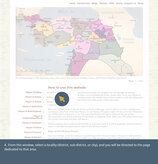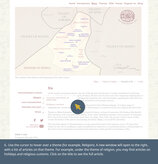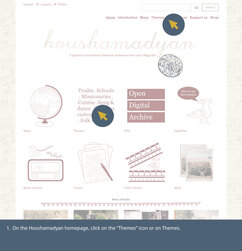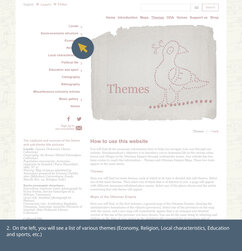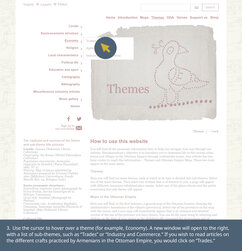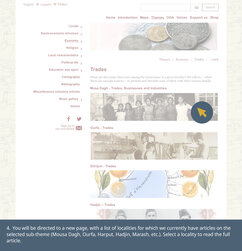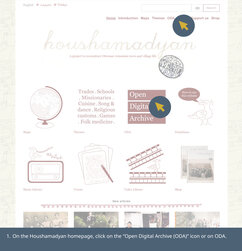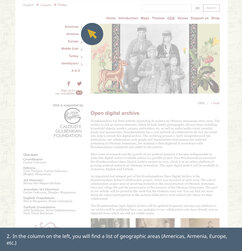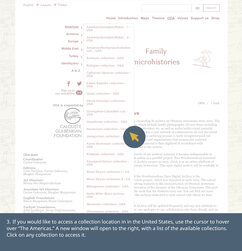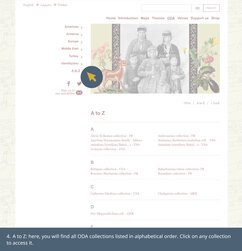Guidelines
Maps
If you are looking for articles on a specific locality (district, subdistrict, etc.), we suggest that you use the “Maps” section to navigate the website.
You can browse the “Maps” section by using our map or by text.
Browsing by Map
- 1. On the Houshamadyan homepage, click on the map or on Maps.
- 2. You will see a general map of the Ottoman Empire, with each vilayet (province) presented in a different color (for example, the province of Adana is in yellow). Click on the desired province.
- 3. You will see a new map, which is an enlarged and detailed view of the province you selected. Use the cursor to select a smaller administrative area.*
- 4. You will see a new map, which is an enlarged and detailed view of the district or sub-district you selected, or a plan of the city you selected.
- 5. In the column on the left, you will see a list of themes (Economy, Religion, Local characteristics, Education and sports, etc.)
- 6. Use the cursor to hover over a specific theme (for example, Religion). A new window will open to the right, with a list of articles on the selected theme. For example, under the theme of religion, you may find articles on holidays and religious customs. Click on the title to see the full article.
* If you are unable to click on an administrative area, we do not currently offer articles on that area.
Browsing by Text
- 1. On the Houshamadyan homepage, click on the map or on Maps.
- 2. Below the map of the Ottoman Empire, in the column on the left, you will see a list of Ottoman provinces.
- 3. Use the cursor to hover over the name of a province (for example, The Vilayet of Adana). A new window will open to the right, with a list of administrative areas within the selected province on which Houshamadyan has articles. For example, under the province of Adana, you may find articles on Sis, Hadjin, and Dörtyol. Articles on additional localities will be added in the future.
- 4. From this window, select a locality (district, sub-district, or city), and you will be directed to the page dedicated to that area.
- 5. In the column on the left, you will see a list of themes (Economy, Religion, Local characteristics, Education and sports, etc.)
- 6. Use the cursor to hover over a theme (for example, Religion). A new window will open to the right, with a list of articles on that theme. For example, under the theme of religion, you may find articles on holidays and religious customs. Click on the title to see the full article.
Themes
If you are looking for articles on specific themes relating to the life of Armenians in the Ottoman Empire, we suggest that you use to “Themes” section to navigate the website.
To navigate this section:
- 1. On the Houshamadyan homepage, click on the “Themes” icon or on Themes.
- 2. On the left, you will see a list of various themes (Economy, Religion, Local characteristics, Education and sports, etc.)
- 3. Use the cursor to hover over a theme (for example, Economy). A new window will open to the right, with a list of sub-themes, such as “Trades” or “Industry and Commerce.” If you wish to read articles on the different crafts practiced by Armenians in the Ottoman Empire, you would click on “Trades.”
- 4. You will be directed to a new page, with a list of localities for which we currently have articles on the selected sub-theme (Mousa Dagh, Ourfa, Harput, Hadjin, Marash, etc.). Select a locality to read the full article.
Open Digital Archive (ODA)
Use Houshamadyan’s “Open Digital Archive (ODA)” section to access chronicles and microhistories, including family chronicles and collections.
How to navigate the ODA:
- 1. On the Houshamadyan homepage, click on the “Open Digital Archive (ODA)” icon or on ODA.
- 2. In the column on the left, you will find a list of geographic areas (Americas, Armenia, Europe, etc.)
- 3. If you would like to access a collection location in in the United States, use the cursor to hover over “The Americas.” A new window will open to the right, with a list of the available collections. Click on any collection to access it.
- 4. A to Z: here, you will find all ODA collections listed in alphabetical order. Click on any collection to access it.

